The Best Turkey Calls [Expert Review and Breakdown]
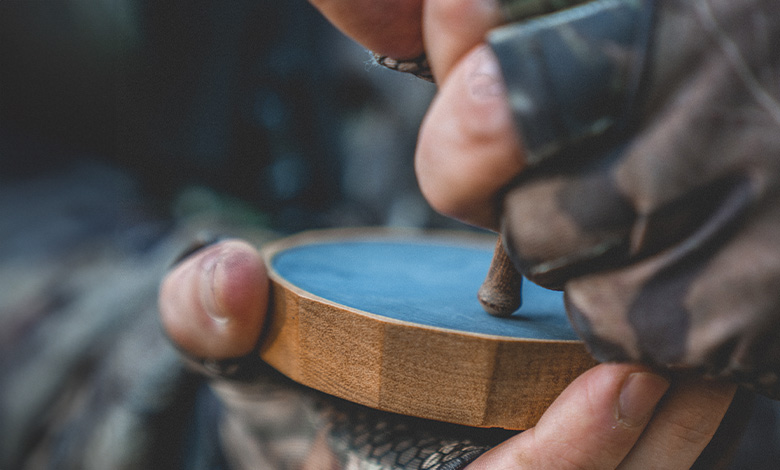
If that boss gobbler is giving you the silent treatment, it is time to bring out a turkey call or two from the vest pocket. The problem is, that you can never know for sure which turkey call sound will work best in a given condition.
To add to the confusion, there are multiple call varieties branching out into a gazillion of products on the market. Spoiling your hard work by choosing the wrong call is the last thing you want.
After checking out some of the top options from the market, we prepared this list of the best turkey calls. Some of these calls are our personal favorites, while others were picked for the high sound quality and ease of use.
Surely, a closer look at the top options will help you to make the right choices based on your hunting preferences.
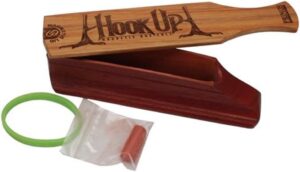
Primos Hook-Up Magnetic Box Call
Description: Features a magnetic hinge design for easy operation and consistent sounds.
Key Features:
- Magnetic hinge
- Waterproof construction
- Includes two calling surfaces
When I saw a friend using this box call, my first reaction was “I need to get one of these.” And the Primos Hook Up box did not disappoint. Firstly, it is beautifully crafted and generates great calls. The lid comes with a patented magnetic hinge which makes it easy to adjust the stroke and sweep. I found the detachable paddle perfect for silent carry.
The yelps, cutts, and purrs generated by the box are realistic and loud enough to attract the toms, so I really believe ut’s one of the best turkey callers. Using the chalk makes the purrs sound even better. It also comes with a gobble band if you want to mimic a dominant tom. The instructions are detailed and using this box call is easy, even for first-time users. Last year, I used this to get responses from birds that were more than 100 yards away.
Overall, this is one of the best box calls you can pick and it works like a charm during spring hunts. At this price, it offers great value too.
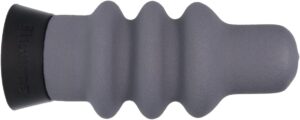
Flextone Thunder Shaker Gobble Turkey Call
Description: Mimics the sound of gobbling turkeys with a shake of the caller’s wrist.
Key Features:
- Compact design
- Easy to use
- Realistic gobble sounds
The compact size makes this turkey call a great handheld option. Made from a mixture of plastic and rubber, this handheld call feels durable. Hunters have used it for 2-3 seasons without damaging the material.
The biggest strength of the shaker is it is super simple to use. Just shake or pump the bellows to generate realistic gobbles. This is a convenient option because mastering the art of generating a gobble by using calls is not easy. When compared to the Flextone Thunder Gen 2 call, this one is less aggressive but not less realistic. The loudness is good, but not great.
I feel this is one of the top turkey calls. I like the ease of use of this shaker gobble but some veterans may prefer to control the call with their voice. Also, you will not be able to generate the whole range of sounds that turkeys make with this call. For something more versatile, look elsewhere.
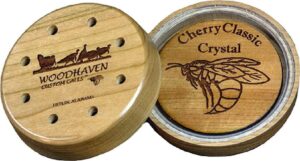
Woodhaven Cherry Classic Series Friction Turkey Call
Description: Crafted from quarter-sawn Cherry this old-school turkey call is an excellent product from Woodhaven
Key Features:
- Premium quality
- Great sound output
- Comes with multiple accessories
This call from Woodhaven is one of the best slate calls you can pick. It is a custom-made call from Cherry– one of the best woods for pot calls. As a result, it generates realistic yelps, clucks, and purrs with sufficient loudness. You can tone it down to quiet clucks and yelps as well. Plus, it nails the kee-kee sound commonly heard during fall.
Even though Woodhaven has done a nice job with the design, it will not be my favorite choice on windy days. The sound output is not as loud as the box calls. But on all other days, the performance is terrific. The call comes with 2 hand-matched strikers, a protective lid, and a conditioning kit. Note, that if you are a first-timer, it will take you some time to get proficient in using it.
Considering the high price tag, this is not the ideal friction call for every hunter. But, once you shift to it from cheaper calls, you will realize what you were missing and that this is one of the best pot calls.
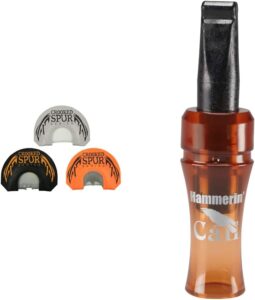
FOXPRO Crooked Spur Mouth Call Combo Pack
Description: Includes three diaphragm mouth calls designed to produce a variety of turkey sounds.
Key Features:
- Three different calls
- Durable construction
- Includes instructional DVD
The Foxpro crooked spur mouth calls offer excellent realism and loudness. You get three calls – the V-cut, the Batwing, and the Gray Double– to imitate a wide range of tones and pitches. The combination of prophylactic material or “proph” and latex gives you the best of both worlds. In my experience, a prophylactic call is easier to use.
All three calls need less air pressure and the yelps and clucks sound like real-life birds. You can use the V-cut to sound like a raspy hen or use the batwing for aggressive cuts. But keep in mind that these are advanced mouth calls and perfecting them will need some practice.
To sum up, this is a great combo pack for making a variety of the best gobble calls. I have been using these calls for over a year and can easily see myself continuing to use them.
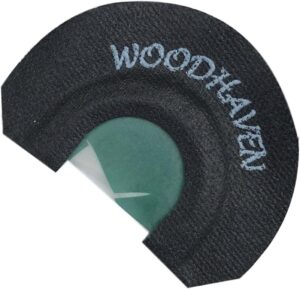
Woodhaven Custom Calls Ninja Hammer Mouth Call
Description: Features a slate calling surface with a walnut pot for producing realistic turkey calls.
Key Features:
- Great design
- Versatile calling options
- Good volume
The Ninja series of calls by Woodhaven are some of the best turkey mouth calls you can pick. I have heard multiple Woodhaven Ninja Hammer calls being used and the sound delivery is consistent. A few years back, I used this call to bring down a tom right off the roost. Be it a raspy yelp, a fast-paced cutt, or a loud cackle, the sounds are crisp and super realistic.
You can control the loudness as well. The green latex used by Woodhaven allows you to use the call for a wide range of hunting scenarios. You can cackle hard or dial back the sound to make the call softer if the bird is closer. Also, compared to some other options, this is a mouth call that is easy to use. You do not need perfect positioning to get the call right.
On the downside, the Hammer does not last long when used hard. But considering the amazing versatility that the Ninja Hammer offers in the field, I will wholeheartedly recommend it.
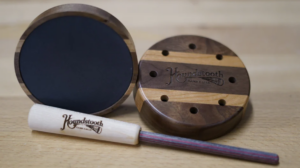
Houndstooth Dixie Hen Slate
Description: A traditional slate call for rich, authentic turkey sounds
Key Features:
- Durable design
- Excellent striker
- Realistic sound quality
While slate calls are easier to master than the diaphragm types, consistency can be an issue with them. That’s where the Dixie Hen Slate from Houndstooth comes in. It is super consistent and the craftsmanship is top-notch. In fact, every Houndstooth call I have seen has excellent quality standards.
Pot calls are made from multiple layers and the workmanship matters. The walnut and cherry finish In the Dixie Hen Slate looks super premium. The slate surface generates perfect yelps and the diamondwood striker allows you to get aggressive when needed. Add in the fact that the compact size makes it fit in your hand perfectly.
The problem with slate calls is that you will have both hands occupied while using it. Other than that, it is hard to find fault with this slate turkey call. You have to shell out a bit more for the Dixie Hen Slate, but if you are looking for solid performance, it is worth it.
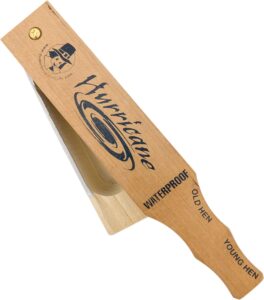
Quaker Boy Hurricane Box Call
Description: Features a waterproof design and dual-sided construction for versatile turkey calls.
Key Features:
- Waterproof,
- Dual-sided
- Produces realistic hen and gobbler sounds
A few great features make the Hurricane Box Call from Quaker Boy stand out in a crowded market. To start with, it has a Maple lid and a Poplar wood bottom. Maple offers a consistent and smooth sound that combines well with Poplar. The volume this best box call generates is excellent and I have heard responses from turkeys that are around 1000 yards away. In terms of realism, it is right on the mark.
A special coating makes the call weather-proof. You can use it in wet conditions as well. The rubbing surfaces are specially treated, eliminating the need to use chalk. Do not sand it either, as that might damage the waterproof coating.
Initially, I was concerned about maintenance but the Hurricane Box does not need any special treatment at all. I love the grip the handle offers and you can use it to sound like an old hen or a young hen. In short, the Hurrican box call is an affordable option that offers excellent value.
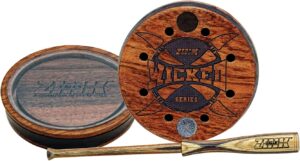
Zink Calls Wicked Series Slate Friction Turkey Call
Description: Slate surface call designed to produce a wide range of turkey vocalizations.
Key Features:
- Custom-designed striker
- Compact size
- Produces realistic turkey sounds
This slate call was my first experience with Zink Calls and it left me impressed. Built from impregnated wood, this hand-tuned call delivers solid realism. The brand mentions that a lot of effort goes into making this call, including hand-sanding and multi-phase curing to ensure perfect smoothness. The precise machining of the wood leaves no doubt about the overall quality.
With acrylic blended into the wood, the call is weatherproof and the sound quality is great. I never had good experiences while using pot calls in the rain. But I used the call on a wet morning in late spring and it worked perfectly. A no-slip grip helps you to make calls with gloves on.
The surface is perfect for generating high-pitched yelps, cutts, and cackles. As a bonus, it has a “built-in sweet spot” for close-distance calls. The laminated striker has a forgiving tip which is great for newbies. I wish the volume was a bit louder, but it works for birds within 500 yards.
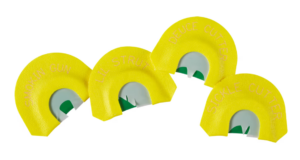
HS Strut Premium Flex 4 Mouth Turkey Call Kit
Description: Includes four diaphragm mouth calls with different reed configurations for versatile calling options.
Key Features:
- Four different calls
- Premium latex reeds
- Produce realistic turkey sounds.
Sometimes, with cheaper calls, the tape around the call is inflexible. That makes it difficult to generate a proper yelp. Thankfully, that is not the case with the Premium Flex 4.
Even so, the outer material is plastic and not as flexible as some of the top-end mouth calls.
All four calls are not equally good though. The loudness from the Smokin Gun and the raspy yelps from the Sickle Cutter were good. However, I could not manage to get a consistent output from the Deuce Cutter and the shrillness was a little too much. It was my least favorite call of the four.
When you consider the price, the Premium Flex 4 kit is a steal, especially for new hunters. These calls are not designed for long-term use, but you can easily replace them after a couple of seasons. Besides, they can be used as practice calls as well.
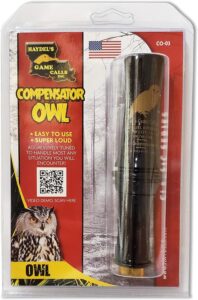
Haydel’s CO-03 Compensator Owl Call
Description: A compensator owl call that is easy to use and delivers a loud output
Key Features:
- Tuned right out of the box
- Produces a realistic hoot
- Durable
Honestly, I am a sucker for owl calls. Be it in the woods or flat country, owl hooter calls have always worked best for me as locator calls. Many senior hunters also consider owl locator calls as real winners.
The advantage of the CO-03 compensator call lies in its design. The compensator plug fixed at the back of the call ensures optimum air pressure. This leads to a perfect call with the right volume– an absolute hoot.
The sound carries over long distances and the CO-03 can be used on windy days without issues. If you have never used a hooter call before, this one is easy to use. The call is made from a polycarbonate material that can withstand abuse with ease. In short, this easily is the best owl locator call on the market to extract a shock gobble.
Types of Turkey Calls
Having a wide range of turkey calls in your toolkit is as important as using the best turkey loads. Here is a quick look at the main types of turkey calls.
Box calls
Most turkey hunters that I know learned calling by using a box call. While a whole new generation of calls has faded the appeal of the old-school box call to some extent, it remains the best choice for beginners as well as pros.
A box call is a narrow rectangular box with a paddle attached to it. The paddle can move back and forth and rub against the top of the box. This pressure and speed at which the two surfaces contact generate friction, which, in turn, creates the sound. In most cases, the underside of the paddle is slightly curved to generate various tones.
Box calls are made from a variety of woods and they generate some of the most natural sounding calls. Many hunters swear that in situations where mouth and diaphragm calls failed to generate gobbles, the box calls worked like a charm. Plus, the sound is loud enough for working with turkey decoys in large open areas or on windy days.
The thing is, the call quality depends on keeping the surfaces clean and free from debris or moisture– something that I found hard while on the field. My clumsy fingers keep touching the calling surfaces and depositing skin oil on them. Application of chalk on the underside of the puddle is also necessary.
Slate calls
Slate calls, also called pot calls, are another friction-type call with a pot, a calling surface, and a striker. The slate surface is attached to the pot that acts as a sound chamber. When the striker is rubbed against the slate, the sound escapes through drilled holes at the bottom of the chamber. But just like box calls, they will keep both your hands occupied. So, make sure to hide your movements from the sharp turkey eyes while using them.
Most pot calls need some conditioning that requires roughening up the surface with an abrasive material like sandpaper. Once prepared, the slate surface can pump out excellent yelps, clucks, and purrs. However, the sound is not as loud as box calls. The soft slate surface can absorb oils and moisture easily and the sound can change over time..
Now, the slate surface can be replaced by glass, crystal, or ceramic. Some pot calls also have crystal or aluminum surfaces. While glass has a sharp pitch, its slick surface becomes unusable with a few drops of spring dew. Ceramic calls last long and can be used for years without much surface prepping. They also work better in wet conditions.
Diaphragm calls
Using a call in your mouth needs more practice, but they are the most realistic option once you get it right. Besides, the diaphragm or a mouth call has excellent versatility and the compact size makes them the minimalist option. The biggest advantage of using this call is the hands-free operation. Frankly, I do not want to be caught fumbling with a box call when a turkey sneaks up on me.
The main parts of a mouth call are the plastic or aluminum frame and a thin latex reed. The reed acts as a membrane and vibrates to produce sound as air passes over it. Calls may have a single or multiple reeds. In addition, mouth calls can have different types of cuts to generate different sounds. Some common cuts are the v-cut, batwing, and ghost cut, although most call makers have their signature cuts.
Another aspect of reed design is the stretch or the tension in it. More stretch results in a lower-pitched call while a low stretch generates a higher pitch.
Push-button calls
While they cannot generate the widest range of yelps and purrs, push-button turkey calls are super easy to use. It requires minimal practice and you can generate a yelp with the push of a finger that operates the striker. With just 10 minutes of practice with a push-button call, you can start generating cutts, cackles, and purrs. While it does not work in wet conditions, you can use it with one hand– a big advantage.
Locator calls
Locator calls are loud sounds that can generate a shock gobble from a turkey. They are great tools, as long as you know when and where to use them. These hand-held calls work based on air pressure variations and are easy to use.
There is no surety about the type of sound that makes a turkey gobble. I have heard turkeys gobble every time a thunder cracked. Some of the popular locator calls use owl calls, crow calls, and hawk calls.

How Do Turkey Calls Work?
The principle of using turkey calls is simple. In truth, it is the same as other hunting calls that have been used for thousands of years by our prehistoric forefathers. You are replicating wild turkey sounds to lure the old tom and trying to bring him closer.
While some animals are lured by mating calls, this is not the case with turkeys. In their case, cutts and yelps are the best calls to attract an excited tom during the turkey mating season.
Turkey calls operate in various ways depending on the design. But primarily, the sound is generated by friction or through vibrations generated by air pressure.
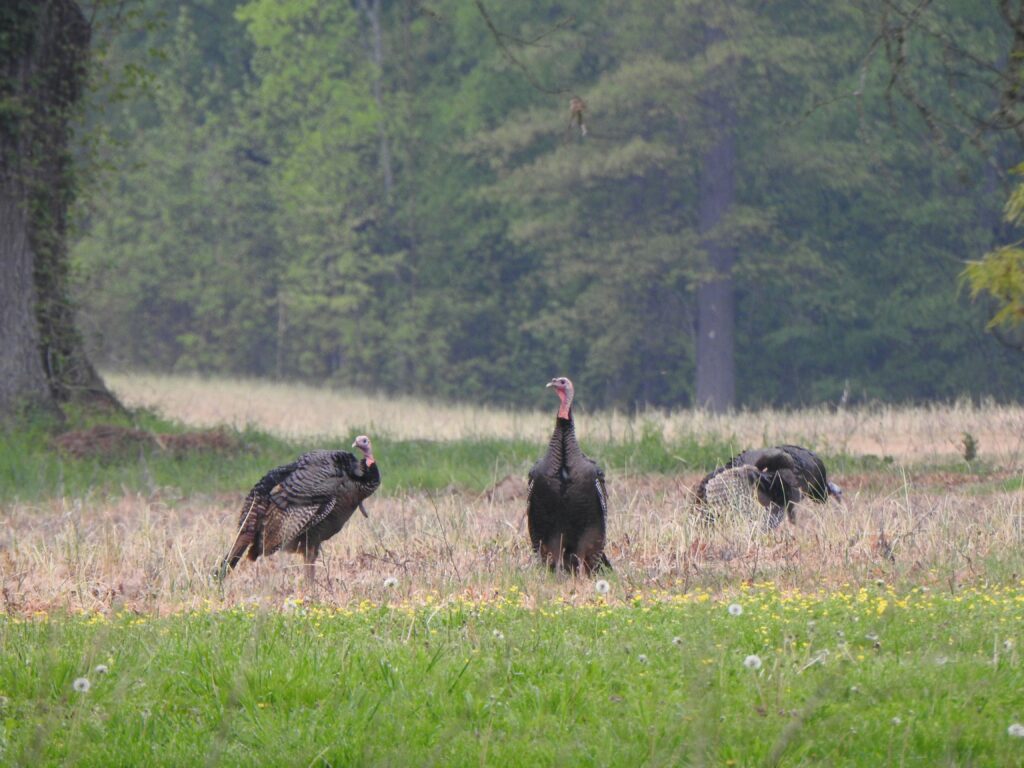
Choosing The Right Turkey Call
Choosing the right turkey call depends on your personal preference, as well as the hunting environment. In general, here are the points that you need to keep in mind.
Sound quality
The call sound quality or purity is one of the most important aspects to keep in mind. In most cases, the sound quality depends on the type of material used and the design. I have found that box calls made from exotic woods can generate more natural turkey call sounds than cheaper woods. Caring for the call is also important. For example, mouth calls require drying and careful storage to keep them in working order.
Ease of use
Ease of use is something that depends on individual preference. With the right amount of practice, you can master all types of calls. But some take more effort to master. As I pointed out, using a diaphragm call needs more practice than a box call. Then again, mastering the gobble can be more difficult than clucks and putts.
I prefer the diaphragm calls for their hands-free convenience but shift to a slate call for a subtle approach. It is necessary to carry multiple options to cover all turkey-calling scenarios. So, putting in the effort to master the not-so-easy calls can help you bag the long beard.
Durability
In terms of durability, box calls made of top-grade wood are the best options. I know of box calls that are more than two decades old but still effective in killing birds. Pot calls do not offer the best durability as the slate or glass is prone to cracking if dropped. Mouth calls are the least durable option. Latex has a shelf life and it will start going bad after that period. Also, new mouth calls sound better than the old ones.
Versatility
In terms of versatility, the diaphragm call stands above the rest of the turkey calls. The box call will come next, followed by the slate call. I am no expert mouth-caller but once I got the hang of it, playing with the tones and pitches was a lot of fun. Plus, they work well with all types of turkey decoy setups.
Price range
While diaphragm calls are the cheapest option, you need to replace them frequently. Many hunters prefer custom turkey calls that are handmade and offer excellent performance. These are higher priced than the average calls on the market. If you ask me, call technique is more important than price.
Picking a $100 box call is not a magic solution to attract gobblers. Heck, I have seen gobblers getting attracted by calls that sounded too horrible to resemble a hen yelp. If you are a frequent hunter, you might need a high-end call that can withstand all weather scenarios. Otherwise, stay within your budget and pick a call that offers the best value.
Skill level
Your experience level matters when choosing a turkey call. Box calls are the most beginner-friendly option — if you can rub two sticks together, you can make this call work.
They’re responsible for more spring gobbler harvests than any other call type simply because they’re easy to use and sound great with minimal practice.
Pot calls (slate or glass) fall in the middle difficulty-wise. If you can hold a pencil, you have the basic skills needed. They require a bit more practice than box calls but offer excellent versatility once mastered.
Diaphragm mouth calls have the steepest learning curve. They demand proper mouth positioning, breath control, and tongue pressure. Many new hunters get frustrated with them, but they’re worth learning because they allow hands-free operation and create the widest range of turkey sounds.
Consider any physical limitations when choosing calls. Some hunters with dentures struggle with mouth calls but excel with box calls. Start with what feels comfortable, and don’t worry if you never master all three types — many successful hunters rely primarily on just one call style they’ve practiced extensively.
Best Turkey Calls: FAQs
What turkey calls do I need?
Start with a box call for volume and ease of use, plus a slate pot call for subtle calling. Add diaphragm mouth calls as you gain experience — they’re hands-free and perfect for close encounters.
A locator call like an owl hooter helps pinpoint gobblers in early morning. Most hunters carry 3-5 different calls, as birds sometimes respond to one call but ignore others. Your collection will grow as you discover what works best for your hunting style.
Is a glass or slate turkey call better?
They serve different purposes. Slate calls produce softer, raspier sounds for close-range calling in calm conditions and are more forgiving for beginners. Glass calls generate higher-pitched sounds that carry further — better for windy days or distant birds.
Glass performs better in damp conditions, while slate can absorb moisture. Many hunters carry both and switch based on conditions. If choosing just one, slate offers more versatility for most scenarios.
How long do turkey mouth calls last?
Diaphragm calls typically last one hunting season with regular use. The latex reeds stretch and degrade over time, affecting tone quality. You’ll notice when a call loses effectiveness — sounds become inconsistent or muffled.
Store calls in their plastic case in a cool, dry place, and always rinse and air-dry after use. It’s wise to replace your primary mouth calls each season. At $5-15 per call, it’s a small investment for reliable performance.
Will a slate call work in the rain?
Standard slate calls perform poorly in rain — moisture creates surface tension that prevents proper friction between striker and slate. Many manufacturers now offer “all-weather” pot calls with treated surfaces that resist water.
Ceramic and aluminum surfaces outperform slate when wet. If rain’s in the forecast, pack a waterproof box call or mouth call as backup. Some hunters apply chalk to combat moisture, but it’s temporary. Your best bet in wet weather is using a call designed specifically for those conditions.
What is the most difficult turkey call type to use?
Diaphragm mouth calls have the steepest learning curve. They require proper mouth positioning, breath control, and tongue pressure to create realistic sounds. Many beginners struggle with clear, consistent yelps without gagging. The finesse needed to transition between different calls takes considerable practice.
However, they offer the highest ceiling for skilled callers, allowing for the most realistic vocalizations once mastered. Practice for 10-15 minutes daily before turkey season, and don’t get discouraged — even experienced hunters took time to become proficient.
Final Thoughts
Like everything else in turkey hunting, choosing the right call is also situational. Using calls is not a foolproof method for attracting the birds. But it definitely gives you an edge against the suspicious long beard. While the magic call does not exist, I consider a box call, a couple of mouth calls, one or two pot calls, and a locator call among the turkey hunting essentials.
Remember, you will need to invest time in dedicated practice to master the turkey call. Once you have done that, you need to know when to put each one to use.
So, these are some of the best turkey calls you can pick. Just make sure not to leave for the field without the right turkey calls in your vest.


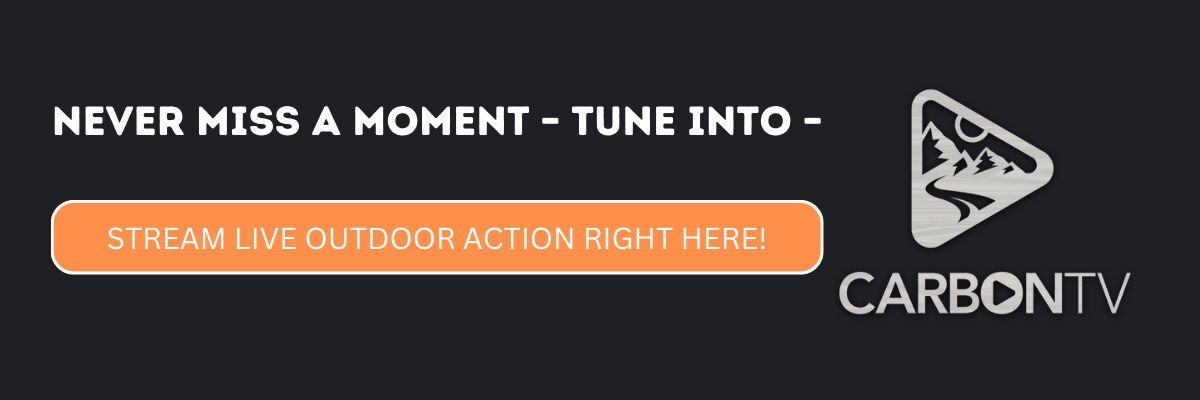
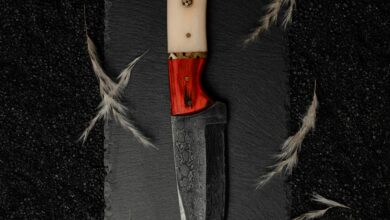
I’ve been turkey hunting for over 35 years & I can honestly say you are spot on about the Woodhaven.. Mike puts out the cherry classic slate pot call & it’s probably the best I’ve ever used.. Ronnie Clough from close calls has the best copper pot called the venom viper you’ll ever use & Steve Reeves from supreme turkey calls has the pure death best cocobolo crystal pot call you ever heard.. JK